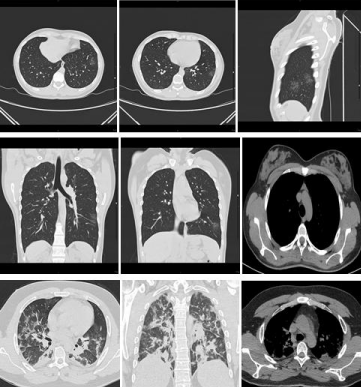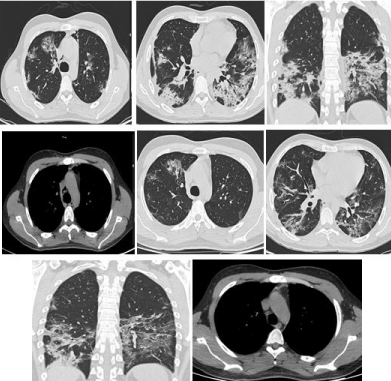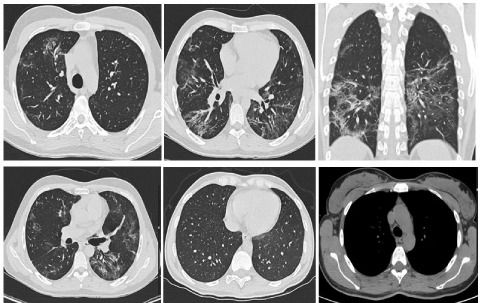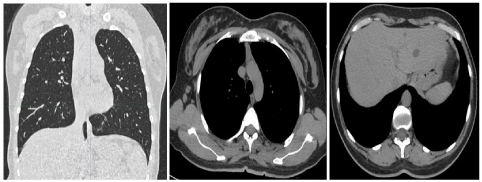
Case Series
Austin J Clin Med. 2021; 7(1): 1040.
High Resolution Computed Tomography (HRCT) Findings in Seven Young Patients Affected by COVID-19 Disease: Can the Persistence of a Thymic Gland Provide a Defensive Influence?
Pinto F¹*, De Rosa G¹, Carfora M¹, di Nuzzo L¹, Scaglione M², D’Auria D³ and Noschese I³
1Department of Radiology, Maddaloni Covid Hospital, Caserta, Italy
2Department of Imaging, Pineta Grande Hospital, Via Domiziana Km, Castel Volturno, Italy
3Department of Advanced Biomedical Sciences, “Federico II University” Unina, Via Pansini, Naples, Italy
*Corresponding author: Pinto F, Department of Radiology, Maddaloni Covid Hospital, Via Libertà, 81024 Maddaloni, Caserta (CE), Italy
Received: May 25, 2021; Accepted: June 19, 2021; Published: June 26, 2021
Abstract
COVID-19 pneumonia is a highly contagious viral pneumonia spread worldwide, caused by SARS-CoV-2. Adults may be more susceptible to disease, especially in those with comorbidities while young people show milder signs of the disease. Between January 1st and February 28th 2021, seven consecutive patients, ranging from 26 to 41 years, were admitted to our hospital with a diagnosis of COVID disease confirmed by a RT-PCR swab test. On HRCT, a Severity Index Score was performed to estimate pulmonary involvement. Focusing our attention on anterior mediastinum, we found that five of the seven cases enrolled had thymic gland. Two patients had not thymic gland. In our preliminary experience, five patients who had thymic gland showed a mild or negative clinical and radiological COVID-19 pneumonia. Instead, two patients who experienced severe COVID-19 pneumonia did not show the thymic gland. Further studies carried out prospectively are needed in order to exceed the limitations of this study and to ascertain the relationship between the persistence of the thymic gland as a protective factor against severe forms of COVID-19 pneumonia.
Keywords: COVID-19; Young patients; Thymic gland ; HRCT pattern
Introduction
A novel coronavirus SARS-CoV-2 was detected for the first time in Wuhan in December 2019 [1]. World Health Organization (WHO) decided to call the disease caused by this virus as Coronavirus disease 2019 (COVID-19) [2]. COVID-19 mostly affects the respiratory system, manifesting with varied clinical pictures ranging from mild upper respiratory tract illness to severe pneumonia with Respiratory Distress Syndrome (ARDS) and death [3]. The virus spreads through droplets and contact with an incubation period between 7-14 days [4]. In accordance to the Centers for Disease Control and Prevention (CDC) assay protocol, the gold standard to diagnose SARS-CoV-2 infection is next-generation sequencing or real-time Reverse Transcription Polymerase Chain Reaction (RT-PCR), methods applied to a respiratory tract sample [5].
Adults and the elderly with comorbidities such as cardiovascular disease, diabetes, chronic obstructive pulmonary disease, asthma, hypertension, or cancer, show more severe signs of the disease and a higher mortality rate than younger subjects without comorbidities. We want to focus our attention on young patients trying to correlate if their symptoms are related to radiological signs [6].
Between January 1st and February 28th, 2021, 7 consecutive patients ranging from 26 to 41 years old (mean age: 33 years old) were admitted to our hospital with a diagnosis of COVID disease confirmed by a positive RT-PCR swab test. They underwent a High Resolution Computed Tomography (HRCT) examination within 3 days after hospitalization due to their clinical condition. Two patients, based on their symptoms and first HRCT report, required some further CT scans. The first one had two follow-up CT examinations 7 and 14 days after initial CT while the second one underwent a follow-up CT scan 9 days from admission CT.
Clinical score: Quick COVID-19 severity index
Quick COVID-19 severity index (qCSI) is a score used to grade the clinical condition’s severity of patients affected by COVID-19 at their admission, based on the respiratory rate, the oxygen saturation, and the oxygen flow rate [7]. This score represents a prognostic tool of early hospital respiratory failure among Emergency Department (ED) patients (Table 1).
Respiratory rate
Points
Pulse oximetry (lowest value recorded during the first four hours of the patient encounter)
Points
O2 flow rate (L/min)
Points
<22 breaths/min
0
>92%
0
= 2
0
23-28 breaths/min
1
89-92%
2
4-Mar
4
>28 breaths/min
2
= 88%
5
6-May
5
Table 1: Quick COVID-19 severity index (qCSI).
Radiological score: CT severity index score
CT Severity Index Score is a semi-quantitative scoring system to estimate the pulmonary involvement including Ground-Glass Opacities–GGO, consolidations, stripes and bands, crazy paving pattern, halo sign [8]. A radiologist with 25 years of experience reviewed chest CT scans of each patient at their admission to assign a CT Severity Score (Table 2).
CT Severity Index Score points for each lobe
Rate of lobe involvement
0
0%
1
0-5 %
2
5-25 %
3
25-50 %
4
50-75 %
5
75-100 %
Table 2: CT scan shows two rounded lobular ground glass opacity (GGO) affecting less than 5% of the entire left lower lobe. A thymic gland is seen in the anterior mediastinum.
Thymus: role and imaging on CT
Thymus is the primary site of T-cell development capable of generating self-tolerant, self major histocompatibility complexrestricted, immunocompetent T cells [9]. It increases in size until puberty when it may weigh approximately 25–30 g, after which time it is not required and so atrophies with age. This loss of functional status is often accompanied by the deposition of large amounts of fat, followed by a reduction of the immune response with age [10]. An analysis of the top five causes of death in the population over 65 years of age, shows that immune insufficiency may be overtly associated with infectious diseases [11]. On CT, thymus appear as a bilobed triangular structure located in the anterior mediastinum, anterior to the proximal ascending aorta, the pulmonary outflow tract and the distal superior vena cava before it enters the right atrium [12].
Case Series
Case 1
Male, 35 y.o., caucasian, with persistent fever > 38.5°C, dry cough but no other significant symptoms. Respiratory rate (0 pt); Pulse oximetry (0 pt); O2 flow rate L/min (0 pt);
qCSI=0 pt. He underwent an HRCT examination, 2 days after his admission, with a CT severity index score=0 (Figure 1). Thymic gland was found (Table 3).

Figure 1: A regular lung pattern is shown at CT. A thymic gland in the anterior
mediastinum is seen.
Points
On admission
qCSI
0
CT severity score
0
Thymic gland
Yes
Table 3: Case 1.
Case 2
Female, 28 y.o, caucasian, with fever > 38°C, dry cough, mild dyspnea.
Respiratory rate (1 pt); Pulse oximetry (0 pt); O2 flow rate L/min (0 pt); qCSI=1 pt.
She performed an HRCT examination, 3 days after her admission at our hospital, with a CT severity index score=1 (Figure 2). Thymic gland was found (Table 4).

Figure 2: CT scan shows two rounded lobular ground glass opacity (GGO)
affecting less than 5% of the entire left lower lobe. A thymic gland is seen in
the anterior mediastinum.
Points
On admission
qCSI
1
CT severity score
1
Thymic gland
Yes
Table 4: Case 2.
Case 3
Male, 31 y.o., caucasian, presenting with fever, moderate dyspnea and hypoxemia.
Respiratory rate (1 pt); Pulse oximetry (2 pt); O2 flow rate L/min (0 pt); qCSI= 3 pt.
He had two HRCT examsinations, on the day of admission and after 9 days. At the first exam CT severity index score was 21, whereas in the follow-up CT after 9 days CT severity index score was 11 (Figure 3). Absence of thymic gland (Table 5).

Figure 3: CT on admission: multiple, bilateral, patchy and confluent GGO with
thickened septea and “crazy paving” pattern in association with segmentary
consolidations in lower lobes. Follow-up CT examinations, 9 days later shows
significant reduction in extension and density of GGO and consolidation
areas too. Note the absence of thymic gland.
Points
On admission
After 9 days
qCSI
3
CT severity score
21
11
Thymic gland
No
Table 5: Case 3.
Case 4
Male, 26 y.o, caucasian, with fever, severe dyspnea and significant hypoxemia treated with O2 therapy. Respiratory rate (1 pt); Pulse oximetry (5 pt); O2 flow rate L/min (4 pt);
qCSI= 10 pt.
He had three HRCT examinations, on admission, and after 7 and 14 days from initial CT. The examination on admission showed a CT severity index score=15, whereas in both the second and the third examinations CT severity index score was 14 (Figure 4). Absence of thymic gland (Table 6).

Figure 4: CT on admission: multiple, bilateral, partially confluent
consolidations especially in lower lobes, associated with lobular GGO,
“crazy paving” pattern and pneumomediastinum. Follow- up CT at 7 days:
no significant consolidations in left lower lobe replaced by fibrotic streaks and
bands. Mild reduction in extension of consolidations in right lower lobe. No
more pneumomediastinum.
Follow-up CT at 14 days: more fibrotic streaks and bands than consolidation
areas but no changes in extension of affected parenchyma. New
pneumomediastinum along the left main bronchus.
Note the absence of thymic gland.
Points
On admission
After 7 days
After 14 days
qCSI
0
CT severity score
15
14
14
Thymic gland
No
Table 6: Case 4.
Case 5
Female, 34 y.o, caucasian, with mild but persistent fever.
Respiratory rate (1 pt); Pulse oximetry (0 pt); O2 flow rate L/min (0 pt); qCSI = 1 pt
She had an HRCT exam, showing no significant radiological pattern of COVID-19 disease (CT severity index score=0) (Figure 5). Thymic gland was found (Table 7).

Figure 5: CT scan, showing a regular lung pattern.
Thymic gland is revealed in the anterior mediastinum.
Points
On admission
qCSI
1
CT severity score
0
Thymic gland
Yes
Table 7: Case 5.
Case 6
Female, 37 y.o, caucasian, with mild but persistent fever, no other significant symptoms.
Respiratory rate (0 pt); Pulse oximetry (0 pt); O2 flow rate L/min (0 pt); qCSI = 0 pt.
She had an HRCT exam with a CT severity index score= 0 (Figure 6). Thymic gland was revealed (Table 8).

Figure 6: Some stripes are shown at the left lung base.
Thymic gland is seen in the anterior mediastinum.
Points
On admission
qCSI
0
CT severity score
0
Thymic gland
Yes
Table 8: Case 6.
Case 7
Female, 41 y.o, caucasian, with moderate (38°C) fever persistent for 3 days.
Respiratory rate (0 pt); Pulse oximery (0 pt); O2 flow rate L/min (0 pt); qCSI = 0 pt
She performed an HRCT exam, showing CT severity index score of 3 (Figure 7). Thymic gland was found (Table 9).

Figure 7: CT exam shows lobular ground glass opacities, especially localized
in both upper lobes; fibrotic stripes and bands at both lung apex and lung
bases. A tiny thymic gland is seen in anterior mediastinum.
Points
On admission
qCSI
0
CT severity score
3
Thymic gland
Yes
Table 9: Case 7.
Discussion
COVID-19 pneumonia is a new highly contagious viral pneumonia spread all over the world, caused by a novel coronavirus (SARS-CoV-2) of still unclear origin. The adults may be more susceptible to the disease, due to pre-existing conditions including hypertension, diabetes, heart disease and smoking, which could weaken their ability to ward off infections but immunosenescence could play an important role in the severity of this disease. Immune system aging is characterized by the paradox of immunosenescence (insufficiency) and inflammation (over-reaction), which incorporate two sides of the same coin, resulting in immune disorder.
Immunosenescence refers to disruption in the structural architecture of immune organs and dysfunction in immune responses, resulting from both aged innate and adaptive immunity. Age-related adaptive immune system deviations, particularly altered T-cell function, are derived from age-related thymic atrophy or involution, a hallmark of thymic aging [13]. This could be the explanation why older subjects or otherwise with atrophy of the thymic gland may show more severe signs of Sars-CoV-2 disease, and, moreover, as in the cases presented, young subjects still showing thymus in CT, have a milder symptomatology and a pulmonary CT pattern of COVID-19.
In our preliminary experience, patients who had the thymic gland showed a mild or negative clinical and radiological picture of COVID-19 pneumonia. Differently, we observed that the two patients who experienced severe COVID-19 pneumonia did not show the thymic gland. Of course, prospective and multicentric studies with a larger series are needed in order to ascertain the relationship between the presence of a thymic gland playing a potential role of protective factor and the severity of COVID-19 pneumonia. We understand that pathophysiology of COVID-19 is likely to rely on unraveling of interplaying mechanisms, including SARS-CoV-2 virulence, human immune response, and complex inflammatory reactions with coagulation playing a major role.
In conclusion, although COVID-19 pneumonia is considered a dangerous illness for the adults and the elderly, especially in those with comorbidities, focus on young patients is mandatory. Whereas radiological findings are similar to the pulmonary patterns revealed in the adults and the elderly patients, the persistence of a thymic gland might be related to patients presenting with a more favourable clinical and radiological pattern of COVID-19 infection [14].
References
- Gupta P, Goyal K, Kanta P, Ghosh A, Singh MP. Novel 2019-coronavirus on new year’s Eve. Indian J Med Microbiol. 2019; 37: 459-477.
- Cascella M, Rajnik M, Aleem A, Dulebohn SC, Di Napoli R. Features, Evaluation, and Treatment of Coronavirus (COVID-19). 2021.
- Grasselli G, Pesenti A, Cecconi M. Critical Care Utilization for the COVID-19 Outbreak in Lombardy, Italy: Early Experience and Forecast During an Emergency Response. JAMA. 2020; 323: 1545-1546.
- Di Nardo M, van Leeuwen G, Loreti A, Barbieri MA, Guner Y, Locatelli F, et al. A literature review of 2019 novel coronavirus (SARS-CoV2) infection in neonates and children. Pediatr Res. 2021; 89: 1101-1108.
- Yu CY, Chan KG, Yean CY, Ang GY. Nucleic Acid-Based Diagnostic Tests for the Detection SARS-CoV-2: An Update. Diagnostics (Basel). 2021; 11: 53.
- Adams ML, Katz DL, Grandpre J. Population-Based Estimates of Chronic Conditions Affecting Risk for Complications from Coronavirus Disease, United States. Emerg Infect Dis. 2020; 26: 1831-1833.
- Haimovich AD, Ravindra NG, Stoytchev S, Young HP, Wilson FP, van Dijk D, et al. Development and Validation of the Quick COVID-19 Severity Index: A Prognostic Tool for Early Clinical Decompensation. Ann Emerg Med. 2020; 76: 442-453.
- Francone M, Iafrate F, Masci GM, Coco S, Cilia F, Manganaro L, et al. Chest CT score in COVID-19 patients: correlation with disease severity and shortterm prognosis. Eur Radiol. 2020; 30: 6808-6817.
- Aw D, Silva AB, Palmer DB. Immunosenescence: emerging challenges for an ageing population. Immunology. 2007; 120: 435-446.
- Zdrojewicz Z, Pachura E, Pachura P. The Thymus: A Forgotten, But Very Important Organ. Adv Clin Exp Med. 2016; 25: 369-375.
- Aspinall R, Andrew D. Thymic involution in aging. J Clin Immunol. 2000; 20: 250-256.
- Nasseri F, Eftekhari F. Clinical and radiologic review of the normal and abnormal thymus: pearls and pitfalls. Radiographics. 2010; 30: 413-428.
- Thomas R, Wang W, Su DM. Contributions of Age-Related Thymic Involution to Immunosenescence and Inflammaging. Immun Ageing. 2020; 17: 2.
- Rehman S, Majeed T, Azam Ansari M, Ali U, Sabit H, Al-Suhaimi EA. Current Scenario of COVID-19 in Pediatric Age Group and Physiology of Immune and Thymus response. Saudi J Biol Sci. 2020; 27: 2567-2573.